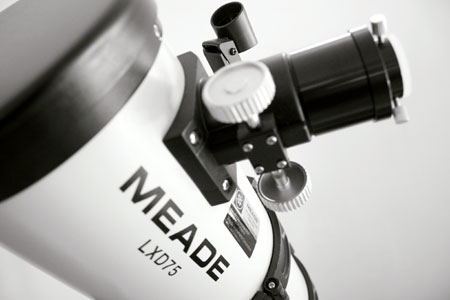Newtonian Reflector Telescopes
Newtonians (also known as catoptrics) usually use a concave parabolic
primary mirror to collect and focus incoming light onto a flat secondary
(diagonal) mirror that in turn reflects the image out of an opening at
the side of the main tube and into the eyepiece. The basic design has been around for hundreds of years and invented by, you guessed it Sir Isaac Newton in 1689.
A bit like the picture
above his one was a 150mm diameter and used his discovery of Newton's Rings to grind and check that the mirrors flat.
Advantages
- Lowest cost per inch of aperture compared to refractors and catadioptrics since mirrors can be produced at less cost than lenses in medium to large apertures.
- Reasonably compact and portable up to focal lengths of 1000mm.
- Excellent for faint deep sky objects such as remote galaxies, nebulae and star clusters due to the generally fast focal ratios (f/4 to f/8).
- Reasonably good for lunar and planetary work.
- Good for deep sky astrophotography (not as convenient and more difficult to use than catadioptrics).
- Low in optical aberrations and delivers very bright images.
Disadvantages
- Open optical tube design allows image-upgrading air currents and air contaminants which over a period of time will degrade the mirror coatings and telescope performance.
- More fragile than refractors or catadioptrics and this require more maintenance (such as collimation).
- Suffer from off-axis coma.
- Large apertures (over 8") are bulky, heavy and tend to be more expensive. For portability 150-200mm are best at f/4-f/8.
- Generally not suited for terrestrial applications.
- Slight light loss due to secondary (diagonal) obstruction when compared
with refractors.
In summary a small reflector is the best general purpose telescope for beginners as they are good on all types of objects and for starting astrophotography.
If you wish for the ultimate planetary telescope, and also a scope which is virtually maintenance free then look no further than a refractor.



